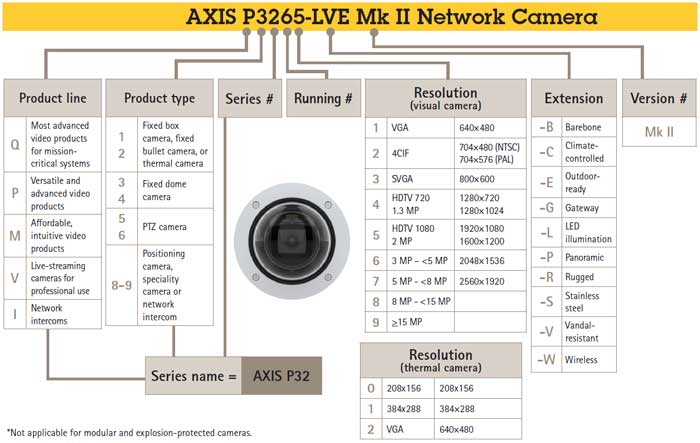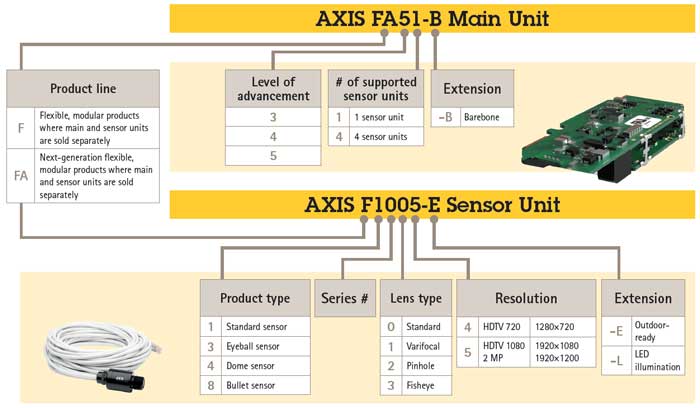As manufacturer of the first-ever network camera, Axis have had a long time to get their naming convention right. With a wide product range, they’ve adapted their naming consistency for different types of products as they've been added to the range.
Let’s dive into what those letters and numbers mean, and if you're interested in the full, detailed naming convention across all Axis products, we have a PDF guide for download below.
IP cameras
This is the biggest section for Axis, who have a vast range of products from static indoor units, to thermal IP cameras, to bispectral PTZ cameras. Axis camera numbers are some of the shortest and most easily understood and are usually in the following format: X1234-XXX. The following table explains what each part of the product name references. To help us explain, let's take the Axis P3265-LVE as our example.
Axis Camera Naming Structure

| Model # | Meaning |
|---|---|
| P |
Product line M = Affordable P = Versatile and advanced Q = Most advanced V = Live stream |
| 3 |
1 or 2 = Box, bullet or thermal camera
3 or 4 = Dome camera 5 or 6 = PTZ 8/9 = Positioning camera, specialty camera or intercom |
| 2 | Series number (1-9) |
| 6 | Running number (0-9) |
| 5 |
Resolution
1 = VGA - 640 x 480 2 = 4CIF – 704 x 576 3 = SVGA – 800 x 600 4 = HD 750p 5 = HD 1080p 6 = 3 - 5mp 7 = 5 – 8mp 8 = 8 – 15mp 9 = 15mp or more |
| -LVE |
C = Climate controlled
E = Enclosure therefore outdoor ready L = LED P = Panoramic S = Stainless steel R = Rugged V = Vandal-resistant W = Wireless |
| Mk II | Version |
Our P3265-LVE is therefore a vandal-resistant, outdoor-ready, 'versatile', advanced dome camera with 1080p resolution and IR LEDs. And we can tell this simply by looking at the product name. Of course, there is much more to this camera than the product name can give away, but the main features and functions are there.
Thermal resolution
Although thermal cameras follow most of the conventions above, their resolution is different, as thermal sensor resolutions are far smaller than optical sensor resolutions. Therefore, the Axis Q1941-E is an outdoor-ready bullet camera with 384 x 288 resolution, as below.
| Model # | Meaning |
|---|---|
|
0
1 2 |
208 x 156
384 x 288 640 x 480 |
Modular cameras
These unconventional devices, with a separate body and sensors, also have a separate naming convention. The product names have a slightly different meaning depending on if you’re talking about a complete camera or separate units. If you’re interested in learning more about these products, read our top 5 reasons to choose a modular camera blog. Let's look at the overall structure, then break it down part-by part in the table below.

Modular base unit naming
The modular base unit is where footage processing happens and is therefore the brain of the device. Despite this, they have a simple naming convention, so the FA54 unit is a next-generation model with four sensors.
Sensor unit
As the lens of the camera, sensors have more parameters to name than base units and therefore more variety with their naming. This makes the FA1005-L a standard static view sensor with HD 1080p resolution.
Base and sensor in one rather than purchasing separate units, Axis also provide “all in one” units, with base and sensor provided together. To differentiate them from the ‘separates’ they start with a different letter: the P1214, for example, is a fixed lens, discreet camera with HD 720 resolution. NB. The letters after a dash in the product name have the same meaning across the entire camera range. the naming convention for Axis' modular cameras is tabled below.
| Model # | Meaning |
|---|---|
| FA |
F = Flexible
FA = Next generation |
| 5 | Level |
| 4 | Number of sensors supported (1 or 4) |
| FA | Product line - F or FA |
| 1 |
1 = Standard
3 = Eyeball 4 = Dome 8 = Stereo |
| 0 | Series # |
| 0 |
Lens
0 = Static 1 = Varifocal 2 = Pinhole 3 = Fisheye |
| 5 |
Resolution
4 = HD 720p 5 = HD 1080p |
| -L |
E = Outdoor
L = LED illumination |
| P | Modular base and sensor |
| 1 | 1 = Fixed modular camera |
| 2 | Series |
| 1 | Running number |
| 4 |
Resolution
0 = 208 x 156 (thermal only) 4 = HD 720p 5 = HD 1080p |
| -E | E = Outdoor ready |
Series naming
Together, the first three numbers and letters form the series name. for example – M50, P32 or Q16. The series name is used frequently by both us and Axis, as they are a ‘family’ of products.
Hopefully, now Axis products make a little more sense. They’re one of the most understandable brands in terms of product naming, making it possible to understand the features of a device before you’ve even landed on the product page. This guide has barely even covered cameras. If you want to understand the entire naming convention, take a look at our Axis Product Naming Structure PDF download.
When you look at Axis cameras on this site, the main features of the product are included in the title. If you’d like any help choosing the right camera for you, please get in touch.



